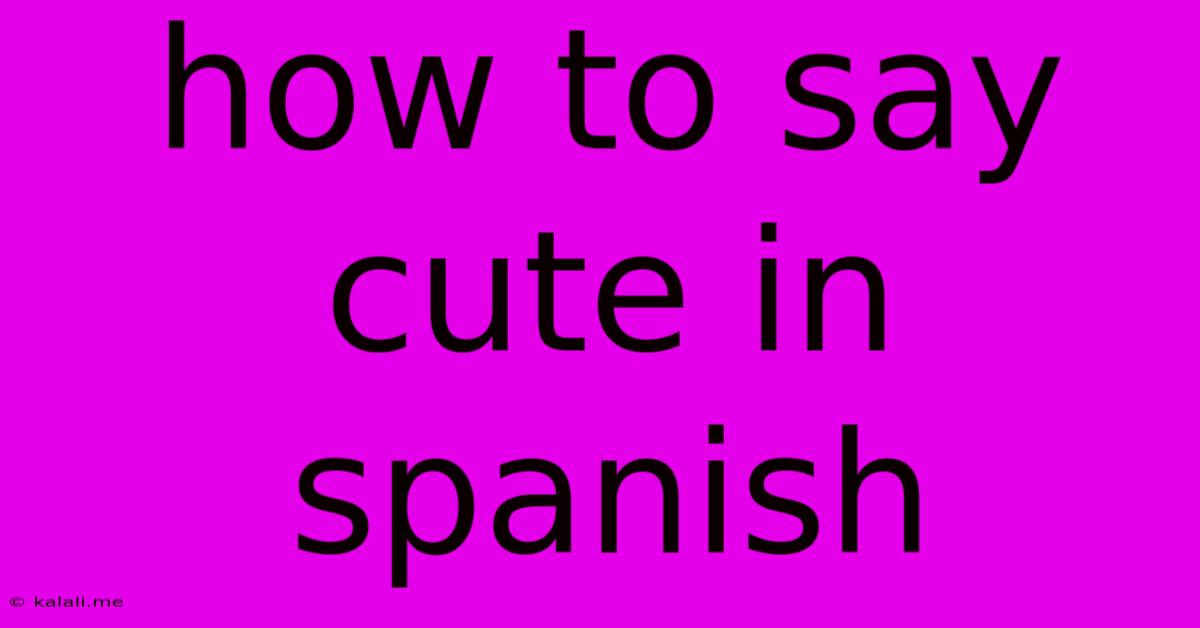How To Say Cute In Spanish
Kalali
May 24, 2025 · 3 min read

Table of Contents
How to Say Cute in Spanish: A Comprehensive Guide
Want to express that something or someone is adorable in Spanish? This guide explores the various ways to say "cute" in Spanish, depending on the context and the nuance you want to convey. We'll delve into the most common terms, their subtle differences in meaning, and offer examples to help you use them correctly. Mastering these words will significantly enhance your Spanish vocabulary and communication skills.
Choosing the Right Word: Context Matters
There isn't one single perfect translation for "cute" in Spanish. The best word choice depends heavily on what you're describing: a baby, a puppy, a dress, or even a person. The level of cuteness also plays a role – is it simply endearing, or overwhelmingly adorable?
Here are some of the most common options and their subtle differences:
1. Lindo/Linda
This is probably the most versatile and widely used term for "cute." Lindo is the masculine form, and linda is the feminine form. It's appropriate for a wide range of things, from babies and animals to objects and even people. It conveys a sense of pleasantness and attractiveness.
- Example: "Ese cachorro es muy lindo." (That puppy is very cute.) "Ella tiene un vestido lindo." (She has a cute dress.)
2. Monito/Monita (Little Monkey)
This term is used affectionately for babies and young children, particularly when they are playful or mischievous. It implies a certain level of charm and cuteness associated with monkey-like behavior.
- Example: "¡Qué monita tan linda!" (What a cute little monkey!)
3. Precioso/Preciosa (Precious)
This word implies something valuable and dearly loved. It expresses a higher degree of cuteness, suggesting something exceptionally adorable and cherished. It is often used for babies, children, and beloved pets.
- Example: "Tu bebé es precioso." (Your baby is precious/cute.)
4. Bonito/Bonita (Pretty/Handsome)
While often used to describe beauty, bonito/bonita can also be used to describe something cute, especially when referring to objects or less animate things. It's a more general term than lindo/linda.
- Example: "Tiene un bonito collar." (She has a cute necklace.)
5. Guapo/Guapa (Handsome/Beautiful)
This is generally used for people, suggesting attractiveness and charm. It can describe someone cute, but usually implies more of an adult's attractiveness.
- Example: "Él es muy guapo." (He is very handsome/cute.)
6. Adorable (Adorable)
This word is a direct loanword from English and is used in Spanish with the same meaning. It's a strong word that suggests overwhelming cuteness and charm.
- Example: "Es un bebé adorable." (It's an adorable baby.)
Beyond the Basics: Adding Emphasis
To enhance the expression of cuteness, you can use adverbs like:
- Muy (very): "Es muy linda." (She is very cute.)
- Increíblemente (incredibly): "Es increíblemente adorable." (She is incredibly adorable.)
- Extremadamente (extremely): "Es extremadamente precioso." (He is extremely precious.)
By understanding these nuances and using them appropriately, you can communicate the precise level of cuteness you intend to convey in Spanish. Practice using these words in different contexts to master their usage and impress your Spanish-speaking friends!
Latest Posts
Latest Posts
-
How To Break Down Junk In Fallout 4
May 24, 2025
-
Can You Run Out Of Oxygen In A Car
May 24, 2025
-
Deployment Does Not Have Minimum Availability
May 24, 2025
-
How To Reply If Someone Is Not Feeling Well Professionally
May 24, 2025
-
I See Said The Blind Man Whole Quote Origin
May 24, 2025
Related Post
Thank you for visiting our website which covers about How To Say Cute In Spanish . We hope the information provided has been useful to you. Feel free to contact us if you have any questions or need further assistance. See you next time and don't miss to bookmark.